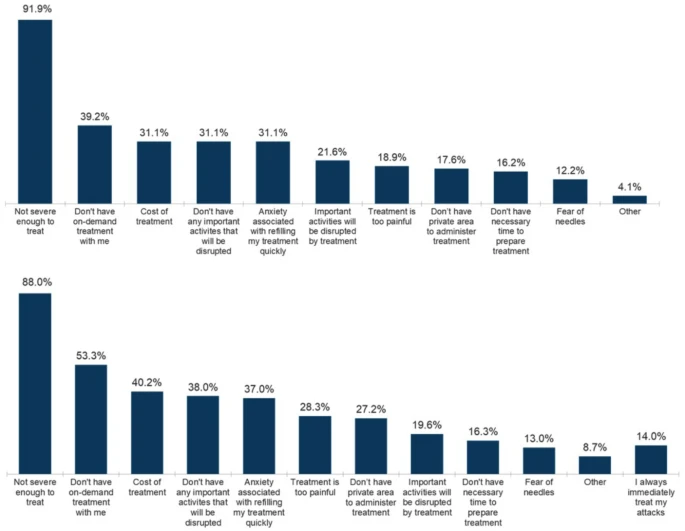Abstract
Background
Hereditary angioedema (HAE) is characterized by debilitating attacks of tissue swelling in various locations. While guidelines recommend the importance of early on-demand treatment, recent data indicate that many patients delay or do not treat their attacks.
Objective
This survey aimed to investigate patient behavior and evaluate the key factors that drive on-demand treatment decision-making, as reported by those living with HAE.
Methods
People living with HAE were recruited by the US Hereditary Angioedema Association (HAEA) to complete a 20-minute online survey between September 6, and October 19, 2022.
Results
Respondents included 107 people with HAE, 80% female, 98% adults (≥ 18 years). Attack management included on-demand therapy only (50%, n = 53) or prophylaxis with on-demand therapy (50%, n = 54). Most patients (63.6%) reported that they did not carry on-demand treatment at all times when away from home. The most common reason for not carrying on-demand treatment when away from home was ‘prefer to treat at home’ (72.1%). Overall, 86% of respondents reported delaying on-demand treatment, despite recognizing the initial onset of an HAE attack and despite 97% of patients agreeing that it is important to recover quickly from an HAE attack. Reasons for non-treatment or treatment delay included ‘the attack is not severe enough to treat’ (91.9% and 88.0%, respectively), ‘cost of treatment’ (31.1% and 40.2%, respectively), anxiety about refilling the prescription for on-demand treatment quickly (31.1% and 37.0%, respectively), the pain (injection or burning) associated with their on-demand treatment (18.9% and 28.3%, respectively), the lack of a suitable/private area to administer on-demand treatment (17.6% and 27.2%, respectively), lack of time to prepare on-demand treatment (16.2% and 16.3%, respectively), and a ‘fear of needles’ (13% and 12.2%, respectively). Survey findings from the patient perspective revealed that when on-demand treatment was delayed, 75% experienced HAE attacks that progressed in severity, and 80% reported longer attack recovery.Conclusions
Survey results highlight that decision-making regarding on-demand treatment in HAE is more complicated than expected. The burden associated with current parenteral on-demand therapies is often the cause of treatment delay, despite acknowledgment that delays may result in progression of HAE attacks and longer time to recovery.


No comments:
Post a Comment